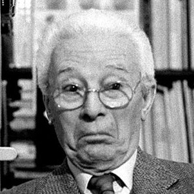Bruno Munari
designer - artist - writer (1907-1998)
Bruno Munari was born in Milan in 1907. Italian artist, designer and writer is one of the great protagonists of the art, design and graphics of the 20th century.
His contribution is fundamental in various fields of visual expression (painting, sculpture, industrial design, graphics, cinematography) and theoretical (writing, teaching, poetry) with a research on the themes of movement, light, creativity and imagination in development through play.
Bruno Munari is the one, as he said of himself, "of forms, inventions, images, unheard of and never seen fantasies".
In 1925 he began working in some graphic design studios in Milan and in 1929 a graphic design and advertising, decoration, photography and exhibition studio together with Riccardo Castagnedi.
In 1930 he invented the "useless machines" that break down and reassemble continuously.
In 1945 he designed new children's books that were still reprinted today. In the same year he designed ORA X "useless machine", an object of "kinetic art" in which the hands are semi-disks that rotate, by means of an alarm spring movement system, on a dial without numbers.
In 1947 he invented new writings of unknown peoples. In 1949 he produced the first "illegible books". In 1950 he painted "negative-positive" with the colors moving in the optical space. In 1952 he uses polarized light.
In 1958 he creates travel sculptures and animated forks, folding the prongs of the forks creates a language of speaking signs.
In 1964 he created "Graphic declination of the name Campari", a poster commissioned for the inauguration of Line M1 of the Milan Metro.
“The poster is meant to be read by a moving train; Bruno Munari thinks of a graphic work of unlimited dimensions, both in length and height. A poster printed in a single format, modular between the individual elements to form an infinite multiple.
An original copy of the poster is now part of the permanent collection of the MoMA in New York and one is visible at the Campari Gallery.
The original xerographs are from 1964. Flexy takes shape in 1968 and always changes shape. In 1971 he invented the Abitacolo for the happiness of children.
In 1974 he explored the fractal possibilities of the curve that takes the name of the Italian mathematician Giuseppe Peano, a curve that Munari fills with colors for purely aesthetic purposes.
In 1977 he designed workshops for children which are now being built in many countries.
Artist, designer, master, painter and writer, Munari's secret is to give the idea that everyone can draw or create as he did, or immediately understand what he was doing.
Not everyone can be a Munari, but it is possible that all those who manage to understand the signs of modern art feel themselves, in millions of ways mirrored in Munari's glances, as in many words in freedom of the Futurists, as in Picabia or in Man Ray, artists who inspired Munari's visions.
Bruno Munari, was a child and became an adult, he perfected a personal visual language, capable of speaking with everyone, at all ages of man.
From his essay "Da cosa nasce cosa" (Ed. Laterza 1996) we understand the meaning of the images in progression of one of his most extraordinary children's books, "Rose nell’insalata", where a row of vegetables, sectioned and stamped, reserve in itself other incredible shapes: the cabbage that contains a tree, the celery that houses spaceships or strange characters, the Treviso area that makes "a little strange rose" ...
Munari is undoubtedly the most eclectic Italian artist-designer. He has always dedicated his creative activity to experimentation, in all its forms and to particular attention for the world of children and games.
His creations in the fields of painting, sculpture, design, photography and teaching cross his various poetics following the thread of his very personal and original vision which he has been able to witness and transmit through his work and his writings, always current.
Over the years he has been awarded many honors. Numerous schools in Europe, America and Asia have awarded him with various titles and everywhere exhibitions dedicated to him are held.
He died on 30 September 1998 in Milan.



















